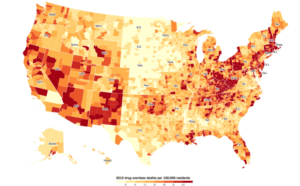Every 19 minutes someone dies from an accidental drug overdose. The Centers for Disease Control and Prevention confirm that 1 in 4 who use opioid painkillers get addicted to them. In a span of 16 years, more than 183,000 people have died in the US from overdoses related to opioids. On average, Americans spend more than $484 billion on opioids every year.
Last week, President Trump declared the opioid crisis a public health emergency, stating that it’s the worst drug crisis in American history.
Yes, Mr. President, you are correct. This is the worst drug crisis in American history.
The opioid epidemic has been ravaging the US for years, and despite the efforts of state and local public health officials in combatting the problem, opioid use and addiction is getting worse.

Getty Images
Why are Opioids so Addictive?
The opioid family includes the street drug heroin and several widely-used prescribed narcotic painkillers like morphine, oxycodone, and hydrocodone.
The latter are prescribed to dull pain, but they also produce chemical messengers called endorphins and dopamine – neurotransmitters giving people a pleasurable high.
With repeated use, the chemicals within the drug can cause the body to stop releasing the natural opiates that the body produces. Therefore, the only way to experience the rush of dopamine or endorphins is to keep taking the drugs – leading to the misuse of prescribed medication and often resulting in addiction.
However, since 2011, prescription opioid consumption and prescription related deaths have leveled off, but deaths from heroin and fentanyl are on the rise. In a more recent and infamous example, toxicology reports show that Prince’s 2016 death was a result from an accidental overdose of fentanyl. The drug is prescribed for cancer treatment, but can also be made on the streets. Even more alarming – it can be 25 to 50 times more potent than heroin and 50 to 100 times more potent than morphine.
Trump Promises a Massive Anti-Drugs Advertising Campaign
A report from the Police Executive Research Forum (PERF) shows that in 2016, nearly as many people died from opioid overdoses as all U.S. fatalities during the entire course of Vietnam.
The report also cited that 11 people died every day in Ohio, the state that suffers the most opiate related deaths.
In an interview last year with Fox Business, Ohio-based Cleveland Clinic’s CEO, Toby Cosgrove, MD, stated: “I don’t think the majority of the people in the United States have any idea of the magnitude of the problem and so you have to raise the consciousness of the whole country,” he said. “You’re going to have to start talking to children in school about the problem…hear it from the pulpits of churches across the country.”
Part of President Trump’s plan includes a targeted advertising campaign of anti-drug propaganda to discourage young kids from trying drugs in the first place. Although there is a political debate on the effect of these type of ads, the Centers for Disease Control and Prevention is continuing to achieve strong results from their national tobacco anti-smoking campaign called Tips, which is said to have helped 400,000 smokers quit for good since 2012.
Speaking of the pharmaceutical impact on the crisis, VIGILINT’s President and Chief Medical Officer Sean Siler believes that the 2001 Joint Commission’s Pain Management Standards lent itself to the problem. The standards helped grow the idea of pain as a “fifth vital sign,” which shaped the way that physicians prescribed narcotics for pain.
“A contributing factor creating this crisis was decades of over-emphasis on pain control, with pain as the ‘fifth vital sign’, and provider payments directly linked to patient satisfaction scores. This skewed the doctor-patient relationship such that providers felt coerced into prescribing narcotics more liberally; in-order to satisfy patient demands and payer requirements. Part of the solution to this crisis lies in repairing that doctor-patient relationship, creating realistic expectations about treatments and pain control, and educating all about the benefits as well as the dangers of narcotic medications in general.”

Is There a Cure for Opioid Addiction?
According to the World Health Organization, no treatment can effectively end opioid dependency so varied options are required, including pharmaceutical treatment and support. Stores like Walgreens have announced that they will stock the drug Narcan Nasal Spray which is an over-the-counter opioid overdose-reversing drug, and can help in acute cases.
Policy makers and the general public understand that people addicted to opioids need treatment, and quickly. However, there is no straightforward solution. Experts agree that fixing the opioid crisis should be a multi-pronged effort based on effectiveness, efficiency and the best use of available resources.
These priorities seem to have been considered in the nationwide Public Health Emergency enacted last week. The directive will allow for states to have more flexibility in how they use federal funds and expand the use of telemedicine treatment. White House officials announced several varied immediate initiatives as a result of the presidential memorandum.
From the Washington Post:
- Patients in isolated areas such as Appalachia will have greater access to opioid treatment through telemedicine and receive prescriptions without seeing a doctor in person, as is generally required under current law.
- The Department of Health and Human Services will speed up its hiring process to have people in place to help states in crisis.
- The federal government will allow states to temporarily shift the use of federal grant funds to target those with opioid addictions.
- The Department of Labor will make Dislocated Worker Grants available to those with opioid addictions and others who were dislocated by this health crisis or who have had trouble finding work because of their addiction.
- The government will spend money from the Public Health Emergency Fund
Although exact figures and cost are still forthcoming, the directive is a step forward by the federal government to combat the crisis that has crossed all socio-economic boundaries and is non-discriminatory in its devastating effects.
